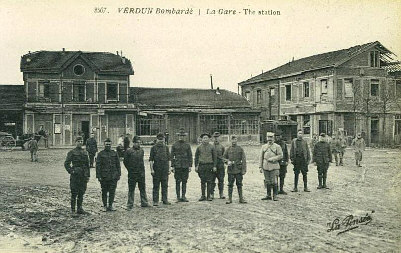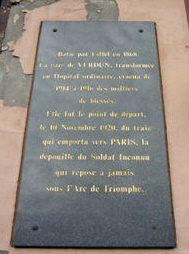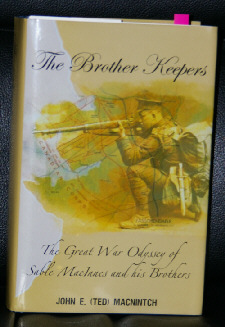Fifth Anniversary Issue
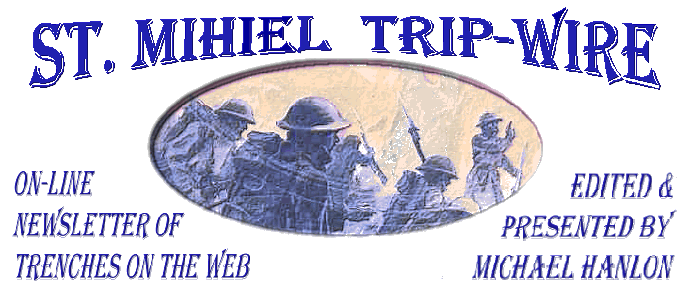
TRENCH REPORT: Well, it's another anniversary and another chance for me to thank our contributors over the past five years [dozens of you], correspondents [thousands of you], and regular and periodic readers [ten of thousands of you]. Some of you have asked, "How long will Mike continue doing this?" My answer is always the same, that I will continue until I get bored with the events of 1914-1918, or I run out of fresh material. As of today, neither of those events are in the foreseeable future. MH
This Month's Internet Feature
Diplomats of the Early & Prewar Period
Count Leopold Berchtold
Theobold von Bethmann Hollweg
Théophile Delcassé
Edward Grey
Col. Edward House
Sergei Sazanov

Russian Army Field Burial
New at Our Own & Our Friends' Great War Websites
Click on Title or Icon to Access
|
At Great War Society Sites
The Great War Society Announces
 |
At the WFA-USA
|
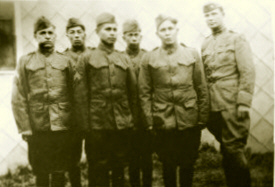
History's First Indian Code Talkers
Members of the Choctaw Tribe and the 36th Division, AEF.
Recently Honored and Recognized

The most memorable religious event of World War I occurred in Portugal--by then a belligerent--in 1917. Three children, Lucia Santos and her cousins Jacinta and Francisco Marto reported visions of the Virgin Mary near the town of Fatima. They said the visions happened on the 13th of each month between May and October. Mary was said to have left the children three secrets, the last of which [it is claimed] involved the assassination attempt on Pope John Paul II. The two cousins died of the Spanish Influenza in 1919 and Lucia lived on as a nun until 2005.
|
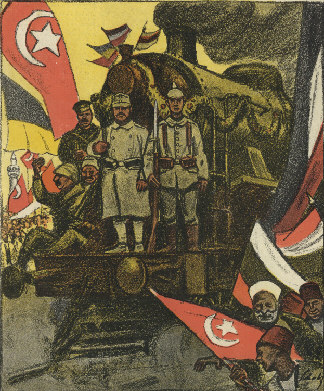
Cover from German Magazine
Simplicissimus, Nov. 1915
GREAT WAR 2007 EVENT CALENDAR
|
1917: Tactics and
Technology
Chief of the Australian Army's
Historical Conference
November 1-2, 2007
Canberra, Australia (email for details)
|
Western Front Association
U.S. Branch Chapter Meetings
Check for Your Region
Regularly Updated (details)
|
Great War Society Monthly Chapter Meetings
Berkeley, San Francisco and Palo Alto, CA
Regularly Updated (details)
|
Send additions/corrections:
Email Response
|

Memorable Event
|
Battle of Cambrai Commences

The Great War's Largest Tank Action
November 20, 1917
Click on Image for Hindenburg's View of the Battle
|
|
In September there was a conference in Kent on Rudyard Kipling and His Son Jack. Here is some information on the conference and a portal to much of Kipling's writings. (link)
We try to be aware of historical anniversaries at the Trip-Wire, but we missed a big one in September. The 6th of September was the 250th anniversary of the birth of Revolutionary War hero and inspiration for the AEF, the Marquis de Lafayette. Lafayette College in Easton Pennsylvania is doing much to honor their namesake and have included much World War I material in their exhibit: 'Lafayette, We Are Here.' (link)
The National World War I Museum at the Liberty Memorial in Kansas City is a "must-see" for WWI students. It is open Tuesday through Sunday from 10 a.m. to 5 p.m., except for Memorial Day, Thanksgiving, Christmas, and New Year's Day. (link).

[In 1915,] Joffre promised to complete the miracle [of the Marne] by achieving a percée, a rupture of the German position in France. But when this failed to occur despite two major offensives. . ., he insisted that France was still winning the war, through gignotage, "nibbling" of the enemy forces through attrition.
From France and the Great War, 1914-1918
Smith, Audoin-Rouzeau, and Becker
|
|
Andre Maginot Monument, Verdun Battlefield Photo by Christina Holstein
|
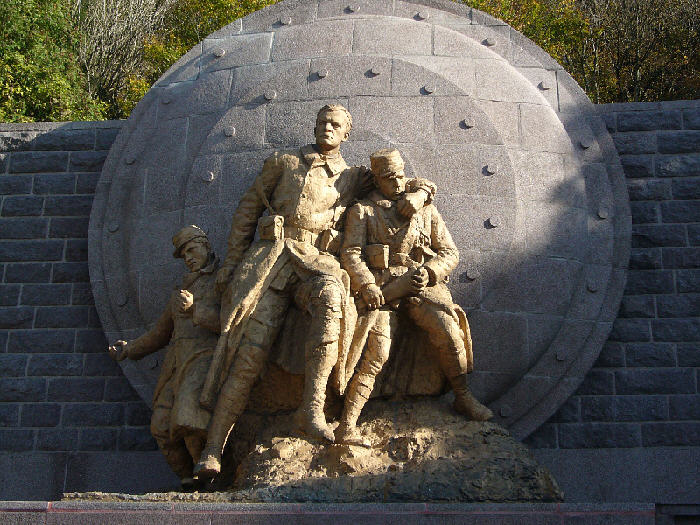
|
|
|
Page Two
|
|
|
Notable Medical Researchers from World War I
Some of the greatest medical researchers of the 20th century served in World War I, often gaining insights and motivation for their later accomplishments from their experiences. Here are five of them:
Capt. Frederick Banting, Canada:
Surgeon, Canadian Army Medical Corps; wounded in action and decorated for heroism; co-discoverer of insulin; Nobel Prize 1923; killed in plane crash en route to service in WWII. |
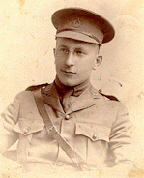 |
Grenadier Gerhard Domagk, Germany:
Volunteer with Leibgrenadier Regiment of Frankfurt; wounded on Eastern Front; transferred to Medical Corps and worked in numerous cholera hospitals; became M.D. after the war; world's leading researcher in chemotherapy; awarded Nobel Prize in 1940; Nazis forced him to decline award, but he was able to accept it in 1947. |
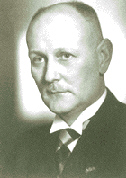 |
Capt. Alexander Fleming, Britain:
Royal Medical Corps, Wound Research Center, Hospital 13, Boulogne, Fr.; inspired by his observations and experiments on the practical effects of antiseptics, he shortly thereafter led effort to develop penicillin; Nobel Prize 1945. |
 |
Lt. Herbert Gasser, U.S.A.:
Chemical Warfare Service; did research on traumatic shock; credited with theory unifying nerve physiology and electrophysics; Nobel Prize 1944. |
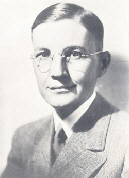 |
Capt. Paul Dudley White, U.S.A.:
Medical Corps American Expeditionary Force; later assisted Red Cross in fighting a typhus epidemic in Macedonia; pioneer in electrocardiography, heart disease research and vascular medicine; gained fame when called in as consultant on President Eisenhower's heart attack; early advocate of exercise and proper diet to prevent heart problems. |
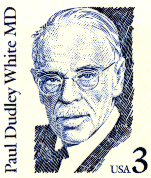 |
|
|

|
The French Unknown Soldier
By Christina Holstein
|
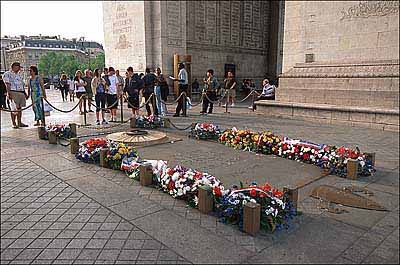
France's Unknown Soldier, Arc de Triomphe, Paris |
The idea of choosing one Unknown Soldier to represent all those who died for France in the Great War was not born after the war but in 1916. Although first proposed by the president of Souvenir Français, the remembrance organisation that cares for French war graves, it was quickly adopted. Various suggestions were made for the place of burial, which had to be both symbolic and easily accessible and in the end, the French Parliament decided that the remains should be transferred to the Arc de Triomphe in Paris. The exhumation sites, which were kept secret, were in eight sectors of the front held by France during the war - Artois, the Somme, Ile de France, Chemin des Dames, Champagne, Lorraine and Verdun.
By midday on 10 November 1920, eight oak coffins, each containing the remains of one unidentified French soldier, had been brought to the underground Citadel at Verdun and placed in one of the galleries. The task of selecting the one to lie under the Arc de Triomphe was given to a war veteran who had served with merit as a simple soldier. However, the veteran chosen - a hero of the Chemin des Dames and Verdun - fell ill at the last minute and a replacement had to be found.
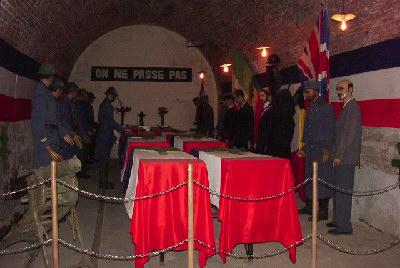
Selection at the Verdun Citadel
The choice fell on Auguste Thin. Born in 1899, Thin had volunteered to serve France in January 1918, having already lost his father during the war. When the Armistice came, he was in the Vosges, and by November 1920 he was serving with the 132nd Infantry in Verdun, with three months' military service left. Called to the colonel of the regiment on 10 November, Thin was informed - to his amazement - that he should draw a new uniform and be ready that afternoon to select the Unknown Soldier.
A few hours later, in the presence of numerous dignitaries, Auguste Thin entered the Citadel. The coffins, each draped with a floor-length tricolour, were laid out in the gallery two by two. By each one stood two much-decorated war veterans. André Maginot, the Minister of Pensions, who was himself a veteran, gave Auguste Thin a small bouquet of flowers to place on the selected coffin and, to a background of muffled drums, Thin stepped forward. He was much moved by the atmosphere and by the task of selecting one hero out of the eight unidentified men. As he hesitated, an idea came to him: his regiment, the 132nd was part of 6 Corps. If he added the numbers of his regiment together, it made 6. That seemed significant and, passing again along the line of coffins, Auguste Thin placed the flowers on the 6th coffin and stood to attention.
Verdun Station, From Where the Unknown Soldier Was Transported to Paris for Burial
Current Commemorative Plaque on Right
The selected coffin was then carried outside and laid with ceremony on a gun carriage drawn by a double team of horses who drew it through the silent, snow-covered streets to the station. There, it was placed on a train to Paris. The following day, in the presence of an immense crowd, the coffin of the Unknown Soldier was blessed by the Archbishop of Paris and laid to rest under the central arch of the Arc de Triomphe.

Seven Unidentified French Soldiers Lie Around the Central Cross in the Faubourg Pavé Cemetery, Verdun
At the same time in Verdun, the seven remaining coffins were buried in the Faubourg Pavé cemetery, where they still lie. Auguste Thin was one of the burial party. Three months later he completed his military service and returned to civilian life. He never forgot his brother in arms under the Arc de Triomphe and the remaining seven anonymous heroes he had helped to bury in the city whose name had become the embodiment of Great War battles.
|

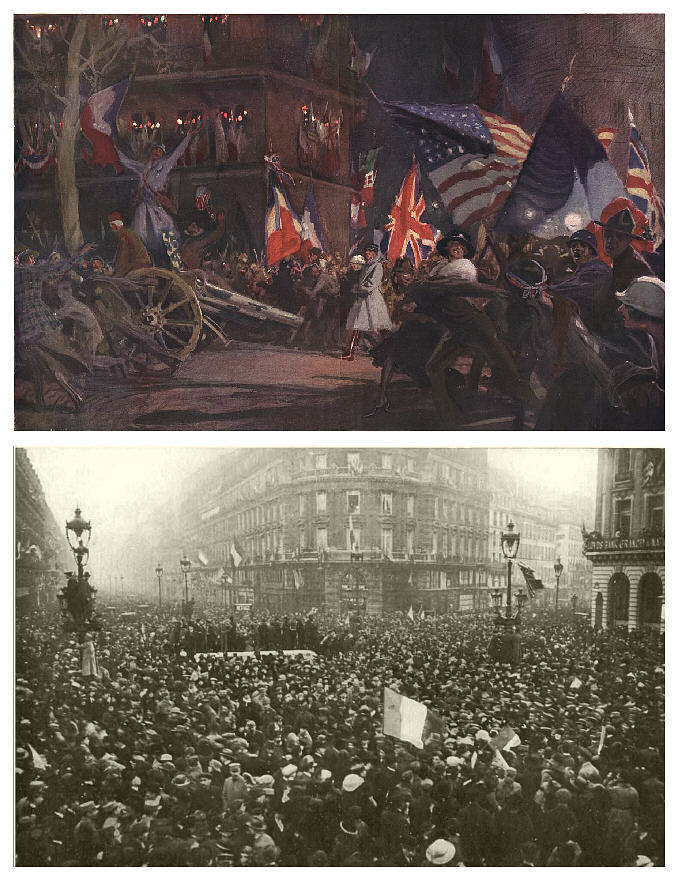
Two Views of Armistice Day in Paris
Click Here to Visit War in a Different Light
|
| Eyewitness: The Verdun Front - August 1917
|
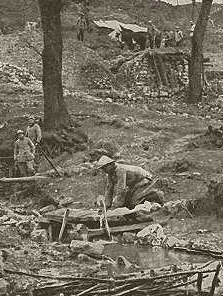
South Slope of Morte Homme |
Dear Aunt Al,
I am supposed to be out on guard duty tonight, but, as it is very quiet and very disagreeable outside, I have dropped into the barn, our headquarters, to tell you how much I appreciated your letter of the 9th of August, which I received only a few days ago. Our Section has just returned from active duty at the front. We evacuated the sector at the extreme left of the last big French drive, which you have probably read about in the papers. The attack itself was a great victory for the French, but it was rather hard on our section. We lost two of our cars from shell fire, and eight of our men are in the hospital suffering from the effects of German gas. The gas produces stomach trouble and a burning sensation in the lungs, both of which are very disagreeable. I myself, being blessed with a robust constitution, have completely recovered from the effects of the gas and am feeling fit and fine. During the two weeks of the attack, our Section carried over three hundred wounded from the front lines back to the triage hospitals. A large majority of them were German prisoners, as the casualties suffered by the French were very small, due to the excellent preparations for the attack by the artillery. Six thousand French guns of all calibers pounded the German lines for three days and nights before the French troops finally went over the top. The front lines now are to the north of hills 304 and Le Mort Homme, but the Germans still hold control of the sector by their occupancy of Montfaucon.
Although many Germans here captured, many more were needlessly killed due to their stupidity. They had built a system of tunnels in Le Mort Homme, which were very wonderful and an indication of their thoroughness. The main tunnel was about four hundred yards long, and lay about three hundred feet below the surface from the top of the hill. Here there were three sets of stairs that served as entrances, one at each end, and one in the middle. The main tunnel was about twelve feet wide and seven feet high. It was well timbered and was kept dry by a series of pumps. Numerous fans provided a good circulation of air, and these were driven by gasoline motored electrical motors that also furnished electric lights for the entire layout. Off the main passage had been constructed numerous rooms, the largest serving as a hospital and the next largest as officers quarters. These rooms were all nicely furnished with furniture that probably was obtained from the captured French cities. I should judge that the layout would furnish very comfortable quarters for several hundred men.
Avery Royce Wolfe
Sections 15 and 31 of the American Field Service
Collected Letters
|
|

|
1917 on The Western Front
By Tony Noyes
November
Passchendaele Finis & The Tanks of Cambrai
|
The Battle of Third Ypres, having started reasonably successfully, then degenerated into the commonly named Battle of Passchendaele and ended in the bottomless mud of November. The name has become synonymous for waste of life and pointless orders to continue the attack irrespective of the ground conditions. The British and Imperial casualties reached 245,000; German figures are not known. Both sides "settled down" in the mud fields to try to survive through the winter. Neither side had "won"; but both sides would carry the memory of the battle into another generation and another war.
To the south of Ypres and east of Arras the Battle of Cambrai was being formulated by the British staff. The heavily fortified
countryside was part of the Hindenburg Line and was being used as a quiet area for German troops to recover from the Passchendaele fighting. Part of the proposed battlefront included the vast, dry bed of the uncompleted Canal du Nord.
Finally, in November the Battle of Cambrai was launched under the leadership of General Sir Julian Byng, now commanding 3rd Army. Originally conceived as a large-scale trench raid, it expanded into history's first significany tank battle. The ground was perfect, rolling, firm and reasonably flat and on 20th November at 0620 in the misty dawn, 376 fighting tanks rolled into action. Their supporting infantry was trained for close cooperation with these very slow moving 27-ton giants. A further 98 were also in action with a variety of uses, including 32 equipped with huge grapnels (like mighty anchors) for pulling the massive barbed wire
entanglements to pieces, and number carrying huge fascines, bundles of brushwood chained tightly
together, ready to be dropped into the German trenches to allow the tanks to pass over.
| One of the first American units involved in combat on the Western Front was drawn into the Battle of Cambrai. The 11th U.S. Engineering Regiment, which specialized in railroad repair, was caught on the Cambrai battlefield when the Germans mounted a surprise counteroffensive.
|
|
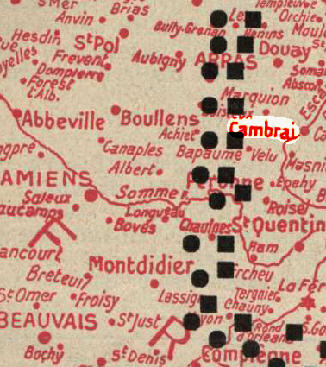
Location of Cambrai Attack On the Western Front
By nightfall, 3rd Army had broken the line to a depth of over four miles on a wide front. Tank losses on this day were 65
written off, 71 more with mechanical problems and 43 ditched. Despite heroic efforts by the crews, mechanical
unreliability and pure human exhaustion, the number of available tanks dropped during the following days, and the early successes began to fade away, with increasing pressure on the infantry. Unfortunately, there were two German strongpoints that could not be taken despite desperate fighting at first or in future days, one at Flesquieres and another the great mass of Bourlon Wood and its sleepy sprawling village. There was also a deep valley at Banteux from which massive German counterattack formations were launched on November 30th. By December 5th, the British were roughly back in their original lines, as were the Germans, and the battle petered out. Tanks had certainly proved their worth and also their weakness in action, and the British took these lessons to heart. That, however, was for next year.
|
|
|
Subscribe to Our New On-Line Magazine
|
|

|
|
|
Page Three
|
Justin Tuveri, 109
Born in Collinas, Sardinia in 1898 a member of the Sassari Brigade, a Sardinian infantry unit nicknamed the "Dimonios" ("Demons" in the island's dialect), Justin Tuveri died on October 5th. Tuveri, who spent most of his life in France, remained active despite his advanced age, pruning trees and cleaning out rain gutters at 90 and driving until age 98, according to the newspaper, Le Monde. He died Oct. 5 at his home in the southern French resort town of St. Tropez, the mayor's office said.
Although Tuveri became a French citizen in 1940, he did not figure on the French Defense Ministry's list of surviving veterans from the 1914-18 war because he had fought for Italy. Only two French veterans from the war are still alive, according to the ministry.

|
 |
John E. (Ted) MacNintch's The Brother Keepers: The Great War Saga of Sable MacInnes and His Brothers
Reviewed by Len Shurtleff
|
This is a massive novel reminiscent of those produced by James Michener. The author, though the eyes of Sable MacInnes one of five brothers, sons of an itinerant Baptist preacher, reveals in detail the course of Canadian participation in World War One. The first ten chapters of the book are devoted to the family life of the brothers as they grow up in rural Nova Scotia and to the culture of the Maritime Provinces. The remaining chapters trace Canada's entry into the Great War and the campaigns of the Canadian Corps on the Western Front. MacNintch's fictional brothers are involved in one way or another in all the major actions of the Canadian Corps: Ypres, the Somme, Passchendaele and the final push to Mons. One brother, who joins the navy, is present at Halifax when the French ammunition ship Mont Blanc explodes there in 1917, leveling half the city. All of this narrative is supported by excellent maps and historically accurate descriptions of the battles, as well as of Canadian politics of the times, based on careful research extending from unit histories to family papers, and a thorough study of the literature and history of the conflict. There are excellent sketches of life in the trenches, relations between Canadians and their allies, as well the weapons (including the Ross rifle) Canadian soldiers fought with. Appendices cover the Canadian Corps (CEF) order of battle in 1917 and contain a detailed glossary of contemporary military slang and terms used in the CEF. Authenticity is enhanced by quotations - set off in italics - from contemporary documents and historical studies.
As most historians of World War One know, the Canadian Corps of five divisions (one of them stationed in England to train replacements) was as large as any of the five British armies on the Western Front and had a complement of artillery larger than most armies. After mid-1917, it was totally under Canadian command, with Lt. General (later Sir Arthur) Currie heading up an experienced, stable and expert staff, many of whom went on lead the Canadian Army in WWII. The Canadian Corps has been described by several historians as the "shock troops" of the British Empire. Readers of this historical novel will discover why.
The author's intent, clearly stated in his preface, is to place Canada's part in the Great War in the proper context with that of the United States. In fact, however, Canada's role need not be compared with that of Woodrow Wilson's America. It stands on its own as a major contribution to Allied victory.
The Brother Keepers: The Great War Saga of Sable MacInnes and His Brothers, John E. (Ted) MacNintch, Sheridan Books, 2007, 779 + xiv pages, photos, maps, appendices, ISBN 0 97875 050 0, $29.95 + $5.00 postage in the U.S. cloth. Order from Aquadoc publications, 20 Pepperidge Trail, Old Saybrook, CT 06475 (link)
|
|
World War I Headlines
in the
21st Century
|
-
Capture of Beersheba by Australian Light Horse Commemorated
- WWI 'Dieters' Had A Lot on Their Plates, Little in Their Pockets
- Lloyd George Memorial Criticized
Last month we recommended an opinion piece by Dr. Thomas Sowell of the Hoover Institution: "Wilsonian No More"
Regular Trip-Wire contributor Len Shurtleff, sent this response to Dr. Sowell's main point. We suggest you read the article first if you haven't done so earlier.
I enjoy reading Sowell because he comes at current issues with a fresh perspective and some useful historical context. Here, however, he is wrong to blame Wilson alone for the rise of self-determination as a rallying cry for nationalists.
The seeds of rampant nationalism existed in the multi-ethnic Ottoman and Austro-Hungarian Empires even before the war. Armenian, Greek and other Christian subjects of the Ottoman Empire were restive. Indeed, Greece, Serbia, Rumania, Bulgaria and Montenegro had already hived off from the Ottomans in the 19th century. Albania became independent during WWI. France, Italy and England conspired for tactical and imperial reasons in 1915 and 1916 to promise bits of both the Ottoman and Austro-Hungarian empires to each other and to Italy, Rumania, Emir Fisal in Arabia and King Peter of Serbia even before the war was over. The post-war peace treaties largely ratified these secret agreements despite Wilson's active opposition to many of them during the Paris peace negotiations among the Allies.
All of these these actions predated Wilson's Fourteen Points speech of January 1918. Indeed, London and Paris were horrified by the breadth and scope of the Fourteen Points. In one sense, Wilson was only recognizing a fact of political life in Europe and the Near East: the thirst for self-government. L.S. |
|
|
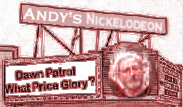 |
Books About World War I Movies
By Andrew Melomet
|
When you want to know more about the World War One movie you've just seen there are a variety of sources to access for further information. The online Internet Move Database (imdb.com) can be used but it is not always reliable. One screenwriter once told me it listed him as dying the year before he won the Academy award for Best Screenplay! Still, it's a good place to start for basic research on a particular title. I find that the external reviews links are often valuable sources of information. Wikipedia.org is another recommended online source that allows a reader to follow up with internal links to other stubs on cast, director and themes. I often browse through online auction catalogues for rare images of movie posters, stills, etc. that can saved for future articles.
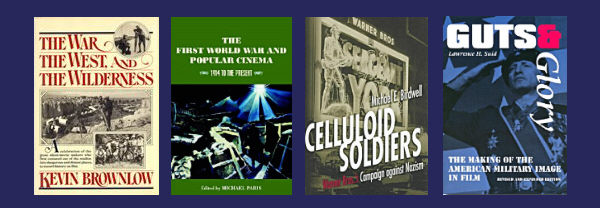
But, at heart, I'm a book person and over the years there are some books and authors that I rely on to provide the additional information and insight that often completes the enjoyment and understanding of a particular movie. Several years ago, I had to the pleasure to participate in a New York Military Affairs Symposium panel discussion on Celluloid Wars: American Feature Films and The Experience of War. One of the speakers was Lawrence H. Suid.
Currently, Larry Suid has three books of particular interest in print and I can recommend all of them. While they do not focus just on World War One movies they do provide a great deal of information on the production of many titles of interest. Larry's books are: Guts & Glory: The Making of the American Military Image in Film, Sailing on the Silver Screen: Hollywood and the U.S. Navy and Stars and Stripes on Screen: A Comprehensive Guide to Portrayals of American Military on Film (with Dolores Haverstick).
Celluloid Wings: The Impact of Movies on Aviation by James H. Farmer is currently out of print but used copies are readily available. His information on the production of Wings, The Dawn Patrol and Hell's Angels are of special interest to WWI aviation movie fans.
The Cinema of Adventure, Romance & Terror edited by George E. Turner contains well-written and well-illustrated articles from the archives of American Cinematographer magazine. Of particular interest are the chapters on Wings, All Quiet on the Western Front, The Lost Patrol and The Black Cat.
I'm proud to have an autographed copy of Kevin Brownlow's The War, The West, And The Wilderness in my collection. Brownlow is one of the foremost living film historians and while a number of his books cover World War One movies in passing; this title devotes a full third of the book to the making of classic World War One movies, both features and documentaries. The acclaimed television series Hollywood: A Celebration of American Silent Film was based on Brownlow's writings and interviews. The episode "Hollywood Goes To War" is highly recommended.
Andrew Kelly specializes in the movies on The Great War. All Quiet On The Western Front: the Story of a Film concentrates on just one title covering not just the production but also the ensuing censorship controversies, as well. Cinema and the Great War covers the British, American, German and French anti-war cinema dealing with the First World War. Kelly has an essay, "The Greatness and Continuing Significance of All Quiet on the Western Front" in The War Film, edited by Robert Eberwein.
I often use Brassey's Guide to War Films by Alun Evans for its comprehensive listings. Chapters and information of World War One movies can be found in History Goes To The Movies by Joseph Roquemore, The Hollywood History of the World by George MacDonald Fraser, History by Hollywood by Robert Brent Toplin, The Columbia Companion To American History on Film edited by Peter C. Rollins, Past Imperfect: History According to the Movies, general editor, Mark C. Carnes, The Great War Films by Lawrence J. Quirk and The Encyclopedia of War Movies by Robert Davenport.
The War Veteran in Film by Emmett Early covers 125 movies that feature the war veteran from the Trojan War to the Vietnam War. Sixteen World War One movies are covered including Heroes For Sale, Johnny Got His Gun and The Razor's Edge.
Celluloid Soldiers: Warner Bros.'s Campaign Against Nazism by Michael E. Birdwell covers the making of Sergeant York and Alvin York's personal conversion from isolationism to interventionism in fascinating detail.
Film And The First World War, edited by Karel Dibbets and Bert Hogenkamp is based on a selection of papers presented at the Fifteenth Conference of the International Association for Media and History held in Amsterdam in 1993. Both cultural historians and film historians provide more than twenty contributions offering an unusual mix of views.
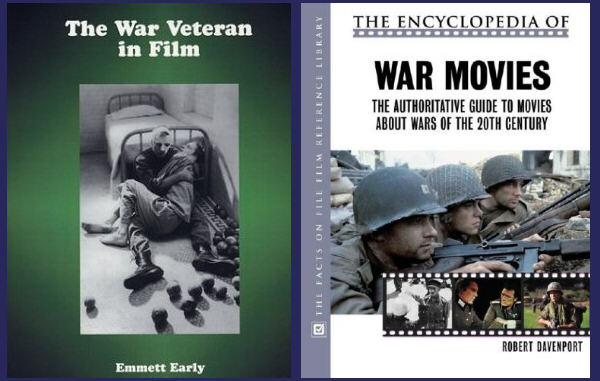
Film Front Weimar: Representations of the First World War in German Films of the Weimar Period (1919-1933) by Bernadette Kester analyzes 25 films and shows how Germany tried to reconcile the horrendous experiences of the war through cinema. If all you know about this period is Westfront 1918 and want to know more, this title is recommended.
The First World War And Popular Cinema 1914 To The Present edited by Michael Paris offers essays covering movies from Britain, Australia, Canada, France, the United States, Italy, Germany, Poland, Austria and Russia. Many of the titles discussed are relatively unknown to audiences in the United States making this title especially appealing to those interested in expanding their cinema horizons.
Hollywood's World War I: Motion Picture Images edited by Peter C. Rollins and John E. O'Connor studies feature films and documentaries. Of particular interest are the chapters on the CBS documentary series on World War One and the making of the documentary The Moving Picture Boys in the Great War. This book is another one of my personal favorites for its comprehensive coverage of both well-known and little-known titles.
These are just some of the titles I use on a regular basis. Of course, some titles require cross referencing and additional research. The Vanishing American (1925) is a western, a war film and a war veteran film. The Roaring Twenties (1939) is a gangster film, a war film and also a war veteran film.
Andrew Melomet, Proprietor of Andy's Nickelodeon, will answer your Great War film or video inquiry. He is also soliciting your recommendations for the WWI Filmography he is compiling for our readers. Just click HERE.
|
|
| The following are thanked for their contributions to this issue of the Trip-Wire: Tom Jones, Eric Harvey, Tony Langley, Jeff Milman, Christina Holstein, Tony Noyes, Andy Melomet, Kimball Worcester, Bob Denison, Bob Ford and Len Shurtleff. Until next month, your editor, Mike Hanlon. |
SUBSCRIBE TO THE TRIP-WIRE
(Or send it to a friend)
(Or send us a comment on the TRIP-WIRE)
CLICK HERE TO CONTACT US VIA EMAIL |
For further information on the events of 1914-1918
and membership information visit the Directory Pages of:
|
| |







